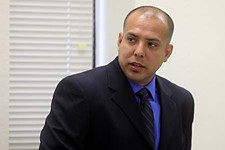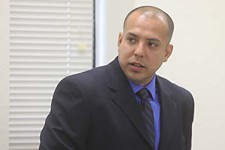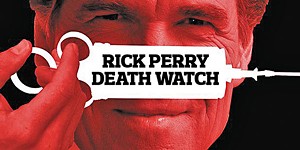'Uncoordinated and Exposed'
The report of Cmdr. Charles Johnson
By Jordan Smith, Fri., April 30, 2010
Johnson recommended findings of "violations" of policy for Quintana's 1) failure to operate his vehicle's mobile video recorder, 2) failure to identify himself as a police officer, and 3) failure to follow his tactical training in a "high-risk" situation. He concluded that Quintana's eventual use of force was "reasonable" under the resulting circumstances, though: "If different tactics had been employed, the necessity to use deadly force may have been avoided entirely." Johnson also noted that because of Quintana's reckless actions and the three officers' "failure to plan and coordinate" their responses, Officers John Hitzelberg and Mohammad Siddiqui were in danger of being accidentally shot by Quintana. The department cannot train for every eventuality, Johnson concluded; training is a fluid exercise, and Quintana should have spotted the need for high-risk procedures and adapted his approach accordingly.
Because of the specific violations and failure to follow tactical procedures, Johnson concluded, Quintana had violated several departmental policies. The Citizen Review Panel agreed, recommending a minimum of 90 days' suspension for Quintana and 15 days for Hitzelberg and Siddiqui. But Chief Art Acevedo overruled those recommendations, suspending Quintana for 15 days and Siddiqui for three – solely for the failure to activate their vehicles' mobile video recorders.
Selected passages from Johnson's report, dated Aug. 11, 2009:
On Quintana's failure to ID as a police officer
"It is clear that Officer Quintana never verbally identified himself as an officer, either before or while he was attempting to wake up Sanders. ... The issue ... has implications that reach far beyond whether or not he committed a minor policy violation. It has a direct bearing on whether Sanders' actions can be interpreted as those of a suspect who initially took armed, aggressive action against someone he knew to be a police officer, or the instinctive defensive reaction of someone, awaking from a sound sleep, in response to feeling someone grabbing his gun. Internal Affairs believes that a possible startled reaction is something that Officer Quintana should have anticipated and could have possibly prevented by verbally identifying himself as an officer."
On the officers' failure to follow tactical training
"In the high risk training, students are taught the importance of planning, timing, and coordination and the division of critical tasks among officers. None of these factors were discussed by the officers prior to them beginning their approach. There was no discussion between the three officers of tactics, roles and responsibilities, or contingencies should the need to take action arise; nor did the officers discuss other options for handling the situation."
"It is unclear why, if Quintana initially planned to use high risk tactics, he chose not to do so once [Michael] Franklin was in custody. What is clear is that, once Hitzelberg and Siddiqui arrived, Officer Quintana did not communicate to them a complete picture of the overall situation; he did not share with them his belief regarding the presence of guns in the vehicle, vital information which was directly related to their officer safety. He allowed them to both walk directly up to the vehicle and look in the windows. Then, without any real planning or discussion, the three officers transitioned to a 'stealth approach' – attempting to sneak up on the subjects while they were sleeping – a tactic which none of them had ever received any training on. ... [A]s was clearly demonstrated, their tactics were uncoordinated and actually left them exposed and with few options once the time came to take action.
"Internal Affairs concludes that this was a 'high risk' situation and that 'high risk' tactics should have been utilized. Internal Affairs concludes that the primary responsibility for determining the approach in this situation rested with Officer Quintana. He initiated the stop and it was 'his' call.
"Officer Quintana failed to follow department standardized training and tactics when it was objectively reasonable to do so. Further, Internal Affairs finds that Officer Quintana failed to employ sound judgment in his decision to confront and attempt to take into custody potentially armed suspects."
On Quintana's use of force
"Quintana's choice of tactics and his approach to Sanders contributed directly to the chain of events that followed, which ultimately led to Quintana using deadly force against Sanders. If different tactics had been employed, the necessity to use deadly force may have been avoided entirely. However, [the use of force allegation] is treated separately, outside the larger situational context.
"Officer Quintana believed that lethal force was reasonably necessary to defend his own life and the life of his fellow officers. ... Forced to make an instantaneous assessment Quintana believed that Smith was pulling a handgun from his waistband and attacking him. The physical evidence (ballistic and forensic evidence) supports Officer Quintana's version of the events."
On Quintana's discharge of shots
"It is clear from his interviews that, at the time he took the shots, he did not know where Officers Hitzelberg and Siddiqui were. Once again, this situation speaks to the officers' failure to plan and coordinate their actions. By failing to establish clear roles and areas of responsibility, they placed themselves in a position that could have led to the accidental shooting of Officers Hitzelberg and Siddiqui or the inadvertent shooting of Sir Smith."
Got something to say on the subject? Send a letter to the editor.










